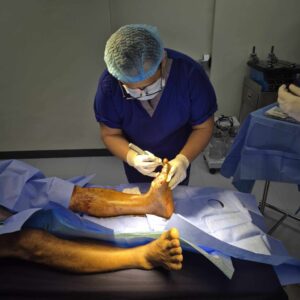Diabetic foot ulcers represent a significant health challenge for many individuals living with diabetes. These wounds develop primarily due to a combination of poor circulation, nerve damage, and a weakened immune system—all common complications of diabetes. Understanding diabetic foot ulcers is essential for timely intervention and effective management. These ulcers typically form on the bottom of the foot or toes, often going unnoticed at first due to reduced sensation caused by nerve damage. The slow healing process in diabetic patients increases the risk of infections, which can lead to severe complications if left untreated. Preventing and managing these ulcers requires awareness of their causes and risk factors, including uncontrolled blood sugar, smoking, and foot injuries. Proper foot care and early detection play a vital role in minimizing the severity and frequency of these ulcers.
Early recognition of diabetic foot ulcers can greatly improve treatment outcomes. People with diabetes should be vigilant about inspecting their feet daily, checking for any cuts, blisters, redness, swelling, or unusual discharge. Since nerve damage can dull pain sensation, many do not feel discomfort until the ulcer has progressed. Swelling or skin discoloration may also indicate early signs of ulcer development. Prompt medical evaluation is critical when any abnormalities are detected. Regular foot examinations by healthcare professionals can catch potential problems before they worsen. Educating patients on foot inspection techniques encourages proactive involvement in their own care, which is a cornerstone of successful diabetic foot ulcer management. Identifying symptoms early helps avoid infections and complications requiring more invasive treatments.
Managing diabetic foot ulcers effectively requires a comprehensive approach tailored to the individual’s needs. Proper wound cleaning is the first step in preventing infection; this usually involves gentle rinsing with saline and removing dead tissue, known as debridement. Dressings are applied to maintain a moist environment that promotes healing while protecting the wound from contaminants. Offloading, or relieving pressure from the ulcer area, is equally important and is often achieved through specialized footwear, casts, or braces. Infection control involves timely use of antibiotics when necessary, based on wound culture results. Advanced treatment options like growth factors, skin substitutes, or negative pressure wound therapy may be considered in persistent cases to accelerate healing. This multifaceted strategy ensures that all factors contributing to ulcer persistence or deterioration are addressed simultaneously, maximizing the chances for recovery.
Blood sugar control plays a fundamental role in the healing of diabetic foot ulcers. Elevated glucose levels impair immune function and reduce blood flow, both of which are critical for tissue repair. Maintaining blood sugar within target ranges helps the body fight infection and supports faster wound closure. Patients are encouraged to work closely with their healthcare team to monitor and adjust their diabetes management plan. This may include medication adjustments, dietary modifications, and increased physical activity as tolerated. Proper hydration and balanced nutrition also contribute to wound healing by supplying essential nutrients needed for tissue regeneration. Emphasizing glycemic control as part of diabetic foot ulcer management highlights the interconnected nature of diabetes care and wound healing.
A multidisciplinary care approach significantly improves the outcomes of diabetic foot ulcer management. Various healthcare specialists contribute unique expertise to treat the patient holistically. Podiatrists focus on foot care and ulcer treatment, while endocrinologists manage overall diabetes control. Wound care nurses and specialists apply advanced treatment techniques and monitor healing progress. Nutritionists guide dietary strategies to support tissue repair and overall health. Physical therapists may assist with mobility and recommend exercises that promote circulation without damaging the affected foot. This coordinated team effort ensures all aspects of the patient’s health are addressed, reducing the risk of complications and recurrence. Patients benefit from comprehensive education and support throughout their healing journey.
Prevention is a key component of managing diabetic foot ulcers to avoid recurrence. Daily foot care routines should include washing feet with mild soap, drying thoroughly especially between toes, and moisturizing to prevent cracks. Proper footwear designed to reduce pressure and protect vulnerable areas is essential. Patients should avoid walking barefoot and regularly trim toenails carefully to prevent injury. Education on lifestyle modifications, such as smoking cessation and weight management, further supports foot health. Scheduling regular follow-ups with healthcare providers helps detect any new problems early. Adopting these preventive measures empowers patients to maintain foot integrity and reduce the likelihood of future ulcers.
Research and technological advances continue to improve diabetic foot ulcer management. Innovative wound dressings with antimicrobial properties, bioengineered skin grafts, and devices that promote oxygenation are among the latest developments. Telemedicine enables remote monitoring and faster intervention when changes in the wound condition occur. Scientists are investigating new drugs and biological therapies to stimulate faster tissue regeneration and combat infection more effectively. These emerging tools promise to enhance healing rates and reduce amputation risk. Staying informed about advancements allows healthcare providers to incorporate cutting-edge solutions into treatment plans. As knowledge expands, patients can expect more effective, less invasive options for managing diabetic foot ulcers.
Frequently Asked Questions (FAQs)
How long does it typically take for a diabetic foot ulcer to heal?
Healing time varies widely depending on ulcer severity, infection presence, blood sugar control, and patient compliance with treatment. Some ulcers may heal in a few weeks with proper care, while others could take several months or longer.
Can diabetic foot ulcers lead to amputation?
Yes, if an ulcer becomes severely infected or gangrenous and does not respond to treatment, amputation may be necessary to prevent the spread of infection and save the patient’s life. Early intervention significantly reduces this risk.
What daily habits help prevent diabetic foot ulcers?
Routine foot inspections, proper hygiene, wearing supportive footwear, avoiding walking barefoot, controlling blood sugar, and regular medical check-ups are crucial daily habits to minimize ulcer risk.
When should surgery be considered in ulcer management?
Surgical intervention may be needed to remove infected or dead tissue, correct foot deformities, or improve blood flow when conservative treatments are insufficient.
How can diabetic patients balance mobility with ulcer care?
Using offloading devices such as special shoes or braces helps protect the ulcer while allowing some degree of mobility. Patients should follow medical advice on weight-bearing restrictions and gradually increase activity as healing progresses.











